
E.O. Hoppé- Anna May Wong, 1925 © E.O. Hoppé Corbis
je l’ai ai achetées donc je les marque puisque personne n’est capable , sauf les bons !!! de citer ses sources; je découvre des sites comme je ne le citerai pas, ( pas de pub pour lui) où mon blog en entier y est!!! Des magazines comme juxtapoz sinon, et ne parlons de the redlist là c’est le bouquet !!!!!
Cela en est assez des personnes qui se servent, qui ne se demandent pas si l’on paie pour avoir ces photos, si on achète des livres, si on redimensionne les photographies, si on les nettoie.
Le self service gratuit. Je dis Non.
« Carlos et Miguel Vargas sont nés dans des circonstances modestes à Arequipa,( isolée de la capitale cosmopolite de Lima, Carlos en 1885 et Miguel en 1887.
Ils ont pratiqué l’art de la photographie au moment où le pictorialisme devenait international. Ils n’étaient pas les seuls ou les premiers photographes de la ville sud du Pérou d’Arequipa. Carlos Heldt, Emilio Diaz, Max T. Vargas, entre autres, les ont précédés. En fait, le Vargas Brothers a appris le métier et l’entreprise de la photographie de Max T. Vargas (pas de lien familial) En 1900. En Août 1912, Carlos et Miguel ouvre leur propre studio « Estudio de Arte Varga Hermanos », en face de la place du studio de Max T, et dès le début, leur activité semble avoir été un succès, leurs réalisations ont été reconnues en Amérique du Sud et même en Europe. En 1925, ils ont remporté une médaille d’or au Salon » Primer Arte Fotográfico » à Buenos Aires, et en 1928 ils ont été présentés à Seville.
Carlos et Miguel Vargas ont consacré leur vie à une création singulière. Alchimistes de l’argent, de la lumière, celluloïde et du verre, ils sont les témoins qui ont laissés une trace de la ville d’Arequipa,de ses visages,, des rêves et des illusions d’une époque. Le monde qu’ils connaissaient a disparu, mais les photos qu’ils ont laissés derrière eux sont des rappels éloquents d’une époque où les forces irrésistibles de la modernité n’avait pas encore balayé les gracieuses, des rythmes sans hâte d’un âge plus formel et élégant. » Traduction du texte de Peter Yenne et Adelma Benavente conservateurs et co-fondateurs du projet Archive photographique de l’exposition de 2007 « City of Night The Vargas brothers sutios ( 1912-1930) »
Rolf Tietgens qui est né en Allemagne, s’est installé es États-Unis en 1939 pour fuir le regime Nazie et a y a très vite trouvé une reconnaissance en étant publié dans de grend magazine.Il partagé un studio à New York avec Ruth Bernhardet c’est par son intermédiare qu’il rencontre il rencontre l’écrivaine Patricia Highsmith , avec qui il aura une relation impossible et complexe jusqu’en 1970 car ce dernier était homosexuel . (Elle a consacré à son livre de 1964, Les Deux Visages de Janvier à cette relation). il réalisera plusieurs nus d’elle, elle a ecrit dans son journal qu’elle espérait ainsi trouver une » entrée », pour une relation avec lui.
Il a aussi réalisé des études plus experimentales » surréalistes » et des photographies documentaires qui ont été publiées dans « photograpy » par exemple.
Il a renoncé à la photographie vers la fin des années 1960 pour des raison de santé et il s’est tourné alors vers la peinture mais il ne rncontrera pas beaucoup de succès dans cette voie.

Rolf Tietgens – Nocturne in New Hampshire, 1939

Rolf Tietgens –Nocturne , 1946
Wallace Berman est né en 1926 à New York et s’installe avec sa famille à Los Angeles, Californie, en 1930. Il a été expulsé de l’école secondaire pour les jeux, et s’il est impliqué dans le monde du jazz.Il s’est inscrit et a participé à la Jepson école d’art et Chouinard mais n’a pas terminé les études il y a. Au lieu de la poursuite d’un art officiel « carrière » il a travaillé dans une usine de finition des meubles. Ce travail lui a donné l’occasion de sauver rejeter les documents et de rebuts qui lui permet de rendre ses sculptures.
Wallace Berman appartient à cette frange d’artistes de la côte Ouest américaine qui, dans l’ombre des années cinquante et soixante forgent une culture ‘beat’ dont la littérature reste l’aspect le plus connu, mais qui s’élabora aussi dans le cinéma, la peinture, la photographie, les collages et les assemblages.Dans les années 1950, Berman est devenu profondément immergé dans le jazz et le blues, il a même écrit une chanson pour Jimmy Witherspoon et realisé la conception de plusieurs pochettes de disques.
En 1957, la Ferus Gallery de Los Angeles lui consacre sa première « et quasiment dernière » exposition personnelle. Les douze « Dessins parchemins » présents renouent avec ses origines juives : sur du papier teinté au brou de noix s’inscrit au hasard cet alphabet hébraïque qui, selon la Kabbale, constitue l’instrument privilégié de la mise en ordre et de l’interprétation du monde. De grands assemblages – à présent disparus – conjuguent par ailleurs constructions en bois, écriture, évocations religieuses et images érotiques qui provoquent la fermeture de l’exposition par les autorités.

Wallace Berman Ferus Gallery Exhibition, 1957 seule planche contact et race qu’il reste de cette exposition
De dépit, W. Berman quitte cette « cité d’anges dégénérés » pour s’établir à San Francisco où la culture ‘beat’ est mieux implantée. Il se repliera désormais sur ce milieu, se refusant à toute vie publique. Il se voue alors à une œuvre plus intime, souple dans sa conception, dans sa manipulation et sa diffusion, la revue « Semina » (1955-1964), dont il imprime les neuf numéros sur une petite presse rudimentaire. Sorte de « méta-collage », « Semina » résume à elle seule tant un certain milieu artistique que la démarche globale de W. Berman. Des pochettes réunissent sur des feuillets libres poèmes, photographies ou collages de W. Berman lui-même comme de ses amis ou des auteurs du passé qu’il admire (Philip Lamantia, Michael McClure, William Burroughs, Hermann Hesse, Antonin Artaud). L’artiste y décline les thèmes en germe dans ses travaux précédents : la drogue, la folie, la violence, la sexualité et l’art rédempteurs, une mystique du quotidien. Grand joueur lui-même, W. Berman propose ici des cartes que chacun peut disposer et ordonner à son gré, recréant indéfiniment l’œuvre.
De retour à Los Angeles en 1961, W. Berman se consacre principalement aux « Verifax Collages » (1961-1976), réalisés à l’aide d’une antique photocopieuse dont la neutralité mécanique va pondérer le contenu iconographique. Les visages effacés des premiers « Verifax » constituent autant une critique de la dépersonnalisation qu’un dispositif où chacun peut se projeter. Puis les images se précisent (clichés d’actualité ou historiques, figures de l’’underground’ ou des minorités, images sexuelles et sensuelles, armes menaçantes, symboles religieux, etc.), mais leur accumulation reste souvent hermétique, laissant volontairement libre cours à l’interprétation. Si les premiers « Verifax » rappellent fortement les « Parchemins », leur forme se structure ensuite pour proposer un véritable écran à nos projections individuelles : une main, démiurgique mais anonyme, manipule une radio dont le haut-parleur est remplacé par une image. Les « Verifax » zappent en silence sur les ondes de l’image. La répétitivité quasi incantatoire des derniers collages rythme un monde fragmenté et bégayant, suggère une distribution inépuisable mais aussi le flux de la pellicule filmique. il Collabore aussi à cette époque étroitement avec Robert Heinecken ( Article Ici et Ici) et Jay DeFeo avec qui il crée des oeuvres à deux mains.
Avant Fluxus et le mail-art, l’art de W. Berman se veut avant tout un mode de communication « naturel » et banal. « Art is Love is God » : comme le résume la devise de ce personnage déjà mythique de son vivant, l’art est une plaque sensible, un exercice spirituel de réception et de transmission du monde, un exercice d’inversion des valeurs visant à banaliser le sacré et à sacraliser le quotidien.
Il a fait son premier et seul film, Aleph, à partir de 1956-1966. Berman ne donne pas le film un titre, Se référant à elle comme « mon film » ou « mon film » et n’a jamais montré à un grand public, préférant à l’écran sur son studio mur sur la base d’un pour un. Le titre « Aleph » a été donnée au travail par Berman, le fils Tosh, après la mort de l’artiste. ( Tosh Berman écrit sur son père des dizaines d’articles ici, notamment sur sa passion pour le jazz mais aussi sur l’ensemble de son oeuvre)
Il a été tué dans un accident automobile par un conducteur en état d’ébriété en Topanga Canyon en 1976.
Mail Art

Wallace Berman-collage from 1963, bearing a note to curator Walter Hopps at the Pasadena Art Museumabout some Edward Weston prints
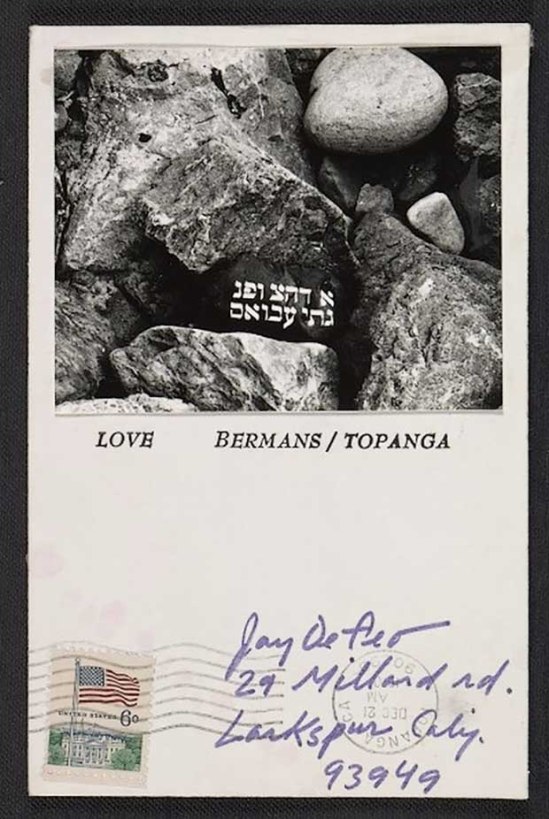
Wallace Berman- mail art for Wallace Berman holiday card to Jay DeFeo, 1970 Dec. 22.,Card features a black and white photo of rocks with white lettering in Hebrew Archives of American Art,

Wallace Berman Mail Art to Robert Duncan and Jess Circa 1962 (Collection Philip Aarons and Shelly Fox Aarons) Courtesy of the Crocker Art Museum
La revue « Semina » (1955-1964)

Wallace Berman with a copy of Semina no. 1 in the Stone Brothers Printing display window, 1957 -© J. Paul Getty Trust. Photo by Charles Brittin

Wallace Berman Semina 1,.jpgSemina cover with photograph of Cameron, 1955, Wallace Berman. Semina journal, no. 1 (1955)
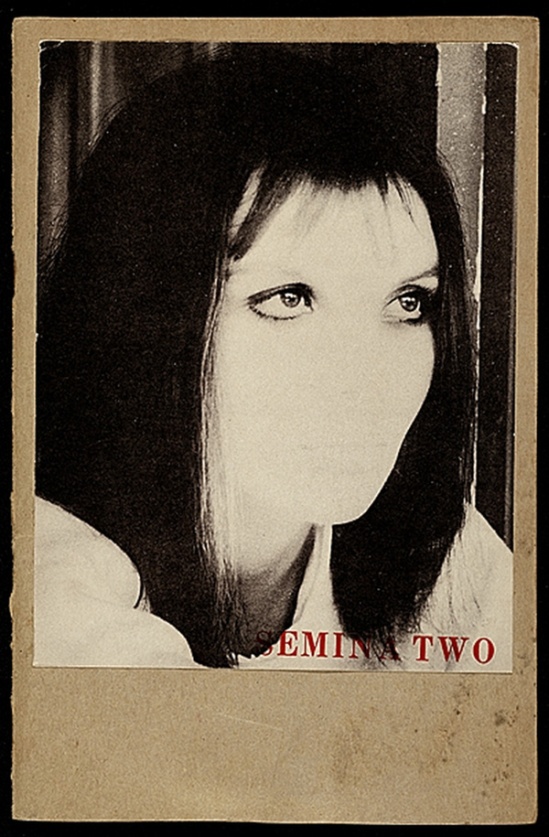
Wallace Berman Semina two, ca. 1956 l’integralité du no Ici

Wallace Berman- Semina cover with Wife (photograph of Shirley Berman), 1959, Wallace Berman. Semina journal, no. 4 (1959)
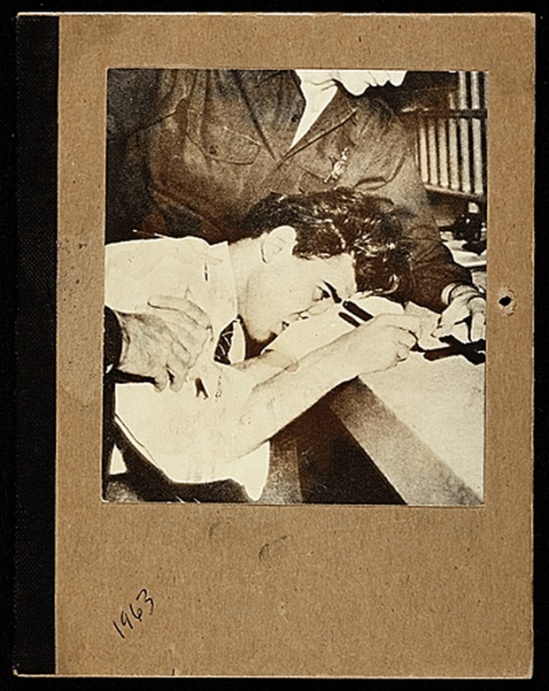
Wallace Berman- Semina 8, 1963 voir l(integralité du no Ici
Verifax Collages

Wallace Berman, “Untitled” (two-ton rock, above and below), Verifax positive, with Polaroid transfer on magazine map.
Autres travaux photographies Collages, installations, poèmes

Wallace Berman, Papa’s Got a Brand New Bag, 1964. Mixed-media collage Collection of David Yorkin and Alix Madigan, Los Angeles. Courtesy the estate of Wallace Berman and Michael Kohn Gallery, Los Angeles.

Wallace Berman, Letter to David Meltzer (football players), 1962. Typed letter with photographic collage,
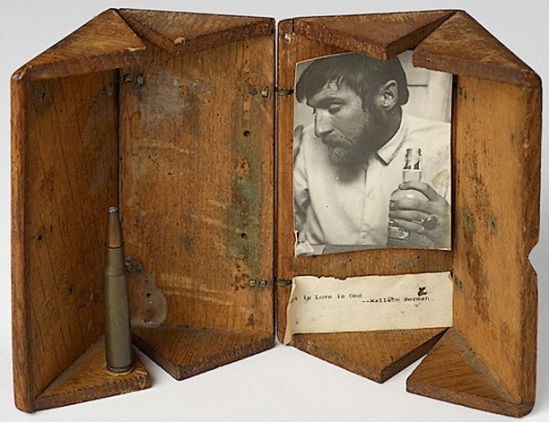
Wallace BermanUntitled (Art is Love is God), 1955, Robert Alexander. Wooden box, photograph, bullet, and paper ourtesy of Galerie Frank Elbaz and Michael Kohn Gallery.
Son Film

Laure Albin-Guillot (French, 1892 – 1962). Nude #18. Vintage photogravure. c1936

Laure Albin Guillot – Les remords , Douze Chansons de Bilitis.Pierre Louÿs’s erotic classic, illustrated by Albin-Guillot’s delicate nudes Paris, J. Dumoulin, 1937.

Laure Albin Guillot – La dormeuse, Douze Chansons de Bilitis. Pierre Louÿs’s erotic classic, illustrated by Albin-Guillot’s delicate nudes Paris, J. Dumoulin, 1937.

Laure Albin Guillot – La berceuse Mnaskidika , Douze Chansons de Bilitis.Pierre Louÿs’s erotic classic, illustrated by Albin-Guillot’s delicate nudes Paris, J. Dumoulin, 1937.

Laure Albin Guillot – La berceuse Mnaskidika , de Douze Chansons de Bilitis.Pierre Louÿs’s erotic classic, illustrated by Albin-Guillot’s delicate nudes Paris, J. Dumoulin, 1937.
More articles about Laure Albin- Guillot

James Hubert-Two Graces, from ‘Cameo’. 1982
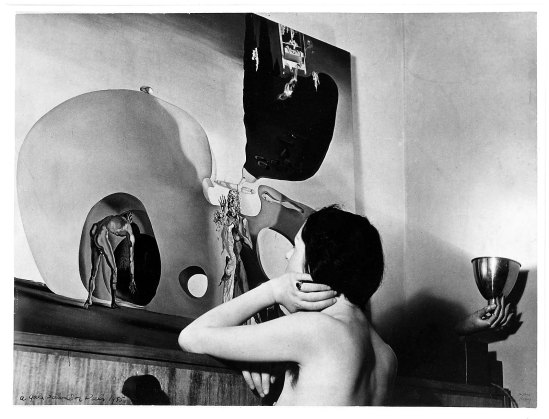
Man Ray – Gala Dali and The Birth of Liquid Desires, 1935© 2011 Man Ray Trust

Renata Bracksieck – Untitled, self portrait, germany,1920s

John Olav Riise – Study of a Lady, 1928
Cook worked in Chicago, and was known for his images of nudes in the Art Nouveau aesthetic. REF: Who Was Who in American Art; biographical information that was originally from the artist.
Cook achieved interesting effects by manipulating his negatives, transforming them into positves.
He mounted the image on to a gold, painted background, allowing the color of the background to be visible in the negative areas, tinting the entire image.

Charles J. Cook- Nude, 1910 sepia tone
Charles J. Cook: Nude by Stream
Oscar Gustave Rejlander (1813-1875) was part of a generation of radical, young photographers working in the 19th century. Rejlander was also an important pioneer of photomontage, a technique that was later embraced by artists as well as photographers. Photomontage has been used by some of the most influential artists of the 20th century. It is a stylistic element that has been utilised by movements that include the Russian avant-garde, Cubism, Futurism, Surrealism, Pop Art, and that continues to be popular among many contemporary artists.
Rejlander was born in Sweden and is widely regarded as the ‘father of art photography’. Rejlander received his general education in Sweden, and studied painting and sculpture in Rome. After considerable travel he settled in England, where from 1853 he practiced photography. Rejlander rejected contemporary conceptions of photography as a scientific or technical medium. In his efforts to elevate photography to the status of a fine art, he made photographs that imitated painting. He looked to the example of the Old Masters for their use of composition and pose, and often set up his own elaborate compositions in his studio. In many of his works he sought painterly effects by combining and superimposing several negatives to make one print, resulting in a final image that moved beyond the results achieved by traditional photography printing techniques. Rejlander was well known for his ability to capture an emotion or sentiment in his work. A series of photographs of facial expressions and gestures made by Rejlander was used by Charles Darwin in his Expression of the Emotions in Man and Animals (1872).
Although he enjoyed a period of critical acclaim, Rejlander died impoverished. However, his influence extended for decades in the form of increasingly frequent debates regarding the merits of pictorialism, painterly effects and the value of more sharply detailed work. A large collection of Rejlander’s work is currently on display at The National Media Museum, Bradford.
Rude Britannnia – Oscar Gustave Rejlander from Henry Lambourne on Vimeo.
More Here
« James Gallagher uses collage to investigate human form and personal identity. His work has been shown in galleries around the world, and he curates a series of exhibitions showcasing contemporary collage entitled Cutters. Gallagher’s art has been featured in publications such as The Lab Magazine, Elephant Magazine, unFlop Paper, NYArts, and Lines & Shapes. His images have appeared in numerous books from Die Gestalten Verlag, including the 2010 title Cutting Edges: Contemporary Collage which Gallagher co-edited. In addition, the street wear company Stussy launched a series of StussyxJamesGallagher tee shirts along with a video profile in 2011. Gallagher earned a BFA from The School of Visual Arts in New York City. In addition to creating art, Gallagher is a Creative Director for a Marketing Firm and an Instructor at Parsons the New School for Design. He lives in Brooklyn with his wife and three kids « http://www.gallagherstudio.net/
and take a look to his old blog Here on blogspot http://jamesgallagher.blogspot.fr/
Tous Droits réservés ©James Gallagher
Vous devez être connecté pour poster un commentaire.